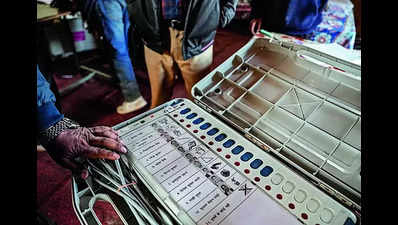- News
- City News
- mumbai News
- Experts: EVMs can’t be connected to any device or system, not even power supply
Trending
Experts: EVMs can’t be connected to any device or system, not even power supply

Likening an EVM machine to a simple calculator that cannot be hacked, Rajat Moona, director, IIT Gandhinagar and a member of the technical panel responsible for designing EVMs, said the current conversation around ways to gain illegal access to the voting machine is political in nature and he would therefore like to steer clear of it, but technically speaking, “no EVM can be hacked into or tampered with”.
American billionaire Elon Musk who said electronic voting machines — like any device — can be compromised, has once again sparked debate that, experts say, surfaces every few years though no one is really able to prove that Indian EVMs can be tampered with. The machines, said experts, are strictly one-time programmable only, do not interact with other systems and are exclusively meant for voting.
The M3 version used in the recently held polls are a smarter version than their predecessor, with several functions that are automated, including a first-level check, like computers carry out before they boot up.
“The EVMs, if tampered with, also have a technology to return to factory setting and stop responding completely,” explained experts. These machines are not connected to the internet nor do they have a radio frequency (RF) to respond to Bluetooth; they are not even connected to a power socket.
Introduced in 2019, the M3 machines will be used for several state polls and have a lifetime of 15 years before they are phased out and an updated version is launched.
“We are already exploring all the new technology that can be brought in for the M4 machines,” said a member of the expert panel.
Interestingly, to “remain completely independent”, none of the panel members charge a fee or accept an honorarium to design the architecture or technology of the EVM machines.
“That was the only way we knew we could remain totally independent,” said Dinesh Sharma, emeritus professor and expert in microelectronics and solid-state electronics at the department of electrical engineering of the Indian Institute of Technology Bombay.
After every election, there are “canards” on how the Indian EVM machines can be hacked; so Sharma has a two-hour-long talk available in the public domain on busting all those myths. He plans to release an updated video in about a month with regards to the new machines and security features in them for general public so that they can repose their faith in Indian voting process.
In his video, Sharma distinguishes between voting machines in other parts of the world and those in India. “Indian EVMs are different from other EVMs in the world. The M3 EVMs have no connection to any other device, not even mains power supply. The EVM machines do not talk to any other device. They are only designed for voting and are not a general-purpose computing device with a loaded programme for electronic voting. So, our EVM can do nothing else. No other programme or software can be loaded on to them. Also, if there is an issue with the system, the machine has to be discarded,” he says in his talk to experts and students. “Each EVM is a unique electronic island in itself, and this makes them super secure.”
At every step, the machines undergo third party review for the software. Mock polling is also done multiple times in the presence of candidates’ representatives, following which, the machines are sealed with “rare” paper from the Nashik security printing press; this is the same paper used to print Indian currency notes.
Each time, the machines are sealed or opened, it is done in the presence of candidates standing for elections or their representatives. Also, when EVMs are transported and stored before polling day, the storage room has to meet strict criteria, like having only one door.
“There is also a provision to allow candidates or their representatives to camp outside 24/7 till the polling day,” explained Sharma.
Interestingly, for the general elections, as per the mandate of the Supreme Court, tallying of ballot slip counts of 20,625 randomly chosen VVPATs with the electronic counts of their control units is carried out. If no mismatch between EVM and VVPAT counts is found in such a sample, then it can be said with near certainty that the sanctity of the election process is not disturbed by the use of EVMs, say experts. Till date, ballot slips of 41,629 randomly selected VVPATs have been tallied with the electronic counts of their Control Units and not a single case of transfer of vote meant for candidate ‘A’ to candidate ‘B’ has been detected.
Differences in count, if any, have always been traceable to human errors like non-deletion of mock-poll votes from the Control Unit or non-removal of mock poll slips from VVPAT, wherein it is possible to identify and remove the mock poll votes. As Moona said, the matter is political in nature, but technically, the “Indian EVMs cannot be hacked”.
End of Article
FOLLOW US ON SOCIAL MEDIA










